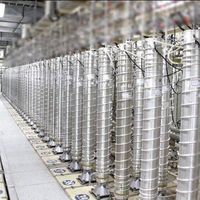A nation on edge: The looming gasoline price hike in Iran
In recent weeks, Iran has been consumed by concerns over a potential gasoline price hike. This anxiety stems not only from economic fears but also from the deep-seated distrust many Iranians have toward their government.
At the center of this storm is the newly installed Pezeshkian administration, which has sent mixed signals about its intentions, further exacerbating the public's concern.
Abdolnaser Hemmati, the Minister of Economy, has tried to calm the waters, stating in a televised interview that no shocking economic measures should be taken, as society cannot bear the brunt of a gasoline price hike or other economic shocks. He emphasized that “any decision to raise gasoline prices must take into account its inevitable inflationary effects.”
But how long can the government spend billions of dollars, selling the cheapest gasoline at around 2 cents a liter or less than 10 cents a gallon, especially when it must import some of it to make up for the shortfall in domestic production.
Yet, Hemmati's words stand in contrast to those of the head of government, Massoud Pezeshkian. In a meeting just days earlier, the new president made it clear that he sees no logic in continuing to subsidize gasoline. “There is no logic in buying gasoline at the open market dollar rate and selling it at a subsidized price,” he said, questioning whether the current policy could continue. His comments only deepened the sense of uncertainty and fear that a price increase might be imminent.
These contradictory remarks have left Iranians wondering what to expect. On one hand, Mohammadreza Aref, First Vice President, reassured the public that the government would not make “any hasty decisions” regarding a gasoline price increase. On the other, Pezeshkian's previous statements, including those made during his election campaign, indicate a belief that the current subsidy system is untenable. In a conversation with Ali Khamenei's website, Pezeshkian argued that Iran’s energy imbalance, where gasoline is purchased for billions of dollars and sold at a fraction of its cost, cannot continue indefinitely.
Pezeshkian’s inconsistent messaging, particularly during the election debates, has only added to the confusion. While he initially supported removing subsidies and raising prices to 250,000 rials (about 42 cents) per liter, he later backtracked, saying that his remarks were taken out of context and that, in governance, such decisions must be left to experts. However, these contradictions have done little to quell public fear, especially given Iran’s recent history.
The specter of past fuel protests looms large. Under Mahmoud Ahmadinejad, the quadrupling of fuel prices led to widespread unrest, with angry citizens setting fire to gas stations in Tehran. Similarly, Hassan Rouhani’s decision to triple gasoline prices sparked protests across the country, resulting in the deaths of nearly 1,500 people as the government suppressed dissent.
Currently, rationed gasoline is sold at 15,000 rials (2.5 cents) per liter, while non-rationed gasoline is sold at 30,000 rials (5 cents) per liter. For many, who earn less than 200 dollars per month a large increase could push an already struggling population to the brink.
Some believe that the Pezeshkian administration’s indecision is not just a political misstep; but it is a recipe for disaster. The country’s economic situation is dire, and people’s livelihoods are hanging by a thread. Rouydad24 news website in Tehran wrote on Saturday that “Any sudden price hike could lead to irreparable damage.”
As economic expert Mehdi Robati noted in a recent tweet, “Analyses based on the increase in gasoline prices and seeing this issue from a one-dimensional perspective are a banana peel under the feet of the Islamic Republic and will not bring any benefit to the country.”
Moreover, public trust in the government is at an all-time low. Many Iranians believe that if there were no fire, there would be no smoke—meaning if the government truly had no plans to raise gasoline prices, there would be no reason to discuss it. Instead, as reported by Rouydad 24, it appears that some advisors are attempting to prepare the public: shock them with the prospect of a significant price hike, only to then offer a gradual increase as a “compromise.”
This strategy is unlikely to succeed. The anger is palpable, with people expressing their discontent on social media. One viral video shows a farmer lambasting Pezeshkian’s comments, saying, “It’s not logical for you to increase gasoline prices and make us villagers and farmers poorer and more desperate by the day.”
Observers say the contradictions within the Pezeshkian administration are more than just political blunders—they are fuel for a fire that, if ignited, could engulf the nation in unrest once again.








